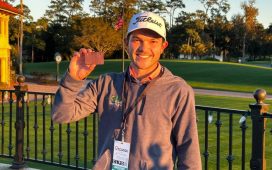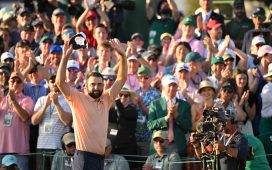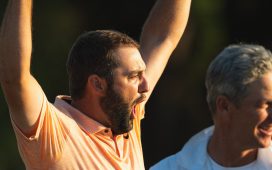AUGUSTA, Ga. — The old man working by a scoreboard near No. 2 knew. He had to have known, because everyone knew.
The roar on Saturday afternoon had all the hallmarks of a classic moment being made at the Masters Tournament: the sharp lift of noise as something sensational unfolded somewhere on the 345 acres, the percussion when the possible became a certainty, and then the fading echoes among the pines.
“Which hole?” the man asked.
The answer, it turned out, was the sixth, where Corey Conners had picked up a pair of strokes with a hole in one, the sixth there in the history of the tournament at Augusta National Golf Club. His tee shot with an eight-iron, coming right after a bogey, had landed just beyond the bunker. The ball took three bounces, each one smaller than the last. Then physics took over in a week when Augusta’s greens have been compared to glass.
It took perhaps four seconds for the ball to enter the cup from the time it struck the green — so fast that Conners had scarcely moved in the tee box. He raised his arms in exultation. He leaned backward and pumped his right fist. He accepted congratulations from Collin Morikawa, his partner for the day.
“It didn’t seem like the wind was helping as much as I anticipated, but, fortunately, it flew far enough,” Conners, who entered Saturday at two under par on the tournament, said afterward. “I was trying to fly it somewhere over the bunker and get it to go in, get it to go close to the hole.”
“I think I hit the pin with a little bit of steam,” he added, “but it was right in the middle, so pretty special moment.”
He finished Saturday with a 68, four under par, and will be in contention when the tournament holds its final round on Sunday, thanks in no small part to his star turn on No. 6.
“Every shot makes a big difference,” said Charles Coody, who won the Masters in 1971 and used a five-iron for a hole in one on No. 6 the following year. “He’s been playing well of late, so I’m quite sure he’ll have a good chance.”
Augusta National’s No. 16 surrenders far more holes in one than any other on the course, and it gave up one on Thursday to Tommy Fleetwood. But the sixth hole has seen more than any spot but the 16th.
“It’s fairly level over there when you’re hitting from the tee and everything,” Coody said of the sixth hole on Saturday, when he watched the tournament on television. “You’re hitting into just a little of the upslope, which helps you hold the green a little better.”
Conners, a 29-year-old Canadian with a single P.G.A. Tour victory to his name, has had, like so many golfers, a complicated relationship with Augusta National. In his first appearance, in 2015, he missed the cut but showed promise: a first-round 80, a second-round 69. Four years later, he tied for 46th after a misery-filled final round. In November, when the pandemic-delayed Masters was played, he scored a 65 in the second round, crucial to tying for 10th in the end.
This year’s conditions were far different.
“It’s got a lot more speed to it,” he said of the course on Tuesday. “The greens are rolling quicker. Had to adjust some of the notes in my book to play a lot more break in the greens, and certain spots around the green where you maybe had a chance in November, you don’t have much of a chance right now.”
He had just finished a practice round with Mike Weir, the 2003 Masters winner and the only son of Canada ever to win one of golf’s major tournaments. Weir regaled Conners with tales of victory — and offered a few tips, one of the traditions of the Masters.
But on Saturday, the afternoon after the cut, Weir was no longer in the field. It was Conners’s turn to stir a roar.








